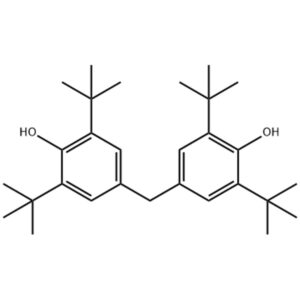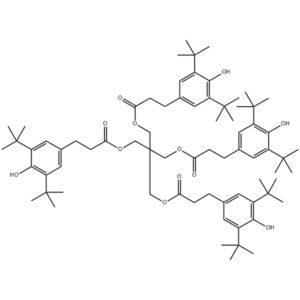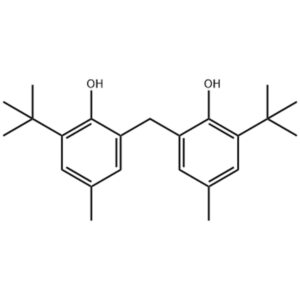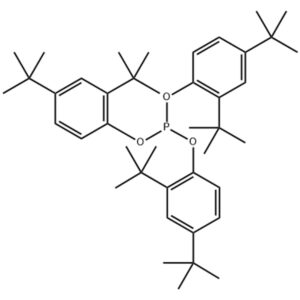Description
CHLUMIAO®DSTDP is a kind of thioester auxiliary antioxidant with excellent performance. Its antioxidant effect is higher than CHLUMIAO®DLTDP, low volatility, low thermal processing loss, no pollution and no coloring. It has a synergistic effect when used together with the main antioxidants CHLUMIAO® 1010 and CHLUMIAO® 1076,CHLUMIAO® CA, etc. It is widely used in petroleum products such as polyethylene, polypropylene, ABS resin, and the general dosage is 0.1% to 1.0%.
| Item | Specifications |
| Appearance | White powder |
| Melting point ℃ | 63.5~68.5 |
| Volatile % | ≤0.05% |
| Ash % | ≤0.01% |
Application:
CHLUMIAO®DSTDP is a kind of thioester auxiliary antioxidant with excellent performance. Its antioxidant effect is higher than CHLUMIAO®DLTDP, low volatility, low thermal processing loss, no pollution and no coloring. It has a synergistic effect when used together with the main antioxidants CHLUMIAO® 1010 and CHLUMIAO® 1076,CHLUMIAO® CA, etc. It is widely used in petroleum products such as polyethylene, polypropylene, ABS resin, and the general dosage is 0.1% to 1.0%.
Storage:
Avoid exposure to the sun or high temperature storage, and should be stored in a cool, dry and ventilated place to prevent moisture, water, and heat.
Package:
Use carton lined with plastic bag, net weight of each box is 25kg
Other Name:
Advastab 802;
Arbestab DSTDP;
Cyanox STDP;
Naugard DSTDP;
Plastanox STDP;
Hostanox SE 2;
Irganox PS 802;
Contact Us Now!
If you need price, please fill in your contact information in the form below, we will usually contact you within 24 hours. You could also email me info@longchangchemical.com during working hours ( 8:30 am to 6:00 pm UTC+8 Mon.~Sat. ) or use the website live chat to get prompt reply.
| Lcanox® 264 | CAS 128-37-0 | Antioxidant 264 / Butylated hydroxytoluene |
| Lcanox® TNPP | CAS 26523-78-4 | Antioxidant TNPP |
| Lcanox® TBHQ | CAS 1948-33-0 | Antioxidant TBHQ |
| Lcanox® SEED | CAS 42774-15-2 | Antioxidant SEED |
| Lcanox® PEPQ | CAS 119345-01-6 | Antioxidant PEPQ |
| Lcanox® PEP-36 | CAS 80693-00-1 | Antioxidant PEP-36 |
| Lcanox® MTBHQ | CAS 1948-33-0 | Antioxidant MTBHQ |
| Lcanox® DSTP | CAS 693-36-7 | Antioxidant DSTP |
| Lcanox® DSTDP | CAS 693-36-7 | Distearyl thiodipropionate |
| Lcanox® DLTDP | CAS 123-28-4 | Dilauryl thiodipropionate |
| Lcanox® DBHQ | CAS 88-58-4 | Antioxidant DBHQ |
| Lcanox® 9228 | CAS 154862-43-8 | Irganox 9228 / Antioxidant 9228 |
| Lcanox® 80 | CAS 90498-90-1 | Irganox 80 / Antioxidant 80 |
| Lcanox® 702 | CAS 118-82-1 | Irganox 702 / Antioxidant 702 / Ethanox 702 |
| Lcanox® 697 | CAS 70331-94-1 | Antioxidant 697 / Irganox 697 / Naugard XL-1 / Antioxidant 697 |
| Lcanox® 626 | CAS 26741-53-7 | Ultranox 626 / Irgafos 126 |
| Lcanox® 5057 | CAS 68411-46-1 | Irganox 5057 / Antioxidant 5057 / Omnistab AN 5057 |
| Lcanox® 330 | CAS 1709-70-2 | Irganox 330 / Antioxidant 330 |
| Lcanox® 3114 | CAS 27676-62-6 | Irganox 3114 / Antioxidant 3114 |
| Lcanox® 3052 | CAS 61167-58-6 | IRGANOX 3052 / 4-methylphenyl Acrylate / Antioxidant 3052 |
| Lcanox® 300 | CAS 96-69-5 | Irganox 300 / Antioxidant 300 |
| Lcanox® 245 | CAS 36443-68-2 | Irganox 245 / Antioxidant 245 |
| Lcanox® 2246 | CAS 119-47-1 | Irganox 2246 / BNX 2246 |
| Lcanox® 1790 | CAS 40601-76-1 | Antioxidant 1790/ Cyanox 1790 / Irganox 1790 |
| Lcanox® 1726 | CAS 110675-26-8 | Antioxidant 1726 / Irganox 1726 / Omnistab AN 1726 |
| Lcanox® 168 | CAS 31570-04-4 | Irganox 168 / Antioxidant 168 |
| Lcanox® 1520 | CAS 110553-27-0 | Irganox 1520 / Antioxidant 1520 |
| Lcanox® 1425 | CAS 65140-91-2 | Irganox 1425 / Dragonox 1425 / Antioxidant 1425 / BNX 1425 |
| Lcanox® 1330 | CAS 1709-70-2 | Irganox 1330 / Ethanox 330 |
| Lcanox® 1222 | CAS 976-56-7 | Antioxidant 1222 / Irganox 1222 |
| Lcanox® 1135 | CAS 125643-61-0 | Irganox 1135 / Antioxidant 1135 |
| Lcanox® 1098 | CAS 23128-74-7 | Irganox 1098 / Antioxidant 1098 |
| Lcanox® 1076 | CAS 2082-79-3 | Irganox 1076 / Antioxidant 1076 |
| Lcanox® 1035 | CAS 41484-35-9 | Irganox 1035 / Antioxidant 1035 |
| Lcanox® 1024 | CAS 32687-78-8 | Irganox 1024 / Antioxidant 1024 |
| Lcanox® 1010 | CAS 6683-19-8 | Irganox 1010 / Antioxidant 1010 |
When we come into contact with plastics or other polymers, we often hear about antioxidants. Perhaps also probably understand that the addition of antioxidants is to antioxidant, anti-aging, but may be a large majority of friends still do not understand the mechanism. Today, we will learn to learn the causes of aging of polymer materials, the mechanism and its solution.
What is oxidation?
Professional explanation: oxidation (oxidation), narrowly defined as the chemical reaction between oxygen and other material elements, is also an important chemical unit process. Broadly speaking, oxidation refers to the process in which a substance loses electrons (the oxidation number rises).
Common explanation: yellowing, aging, hardening, brittleness, softening, dullness, rusting and other phenomena caused by wind, sun and rain, oxygen in the air, hydrodynamic and wind erosion can be roughly categorised as oxidation.
The best example is the phenomenon of a cut apple, exposed to the air for some time, gradually turning yellow. In fact, not only apples will oxidise, our skin will also oxidise, plastic products and polymers will oxidise and age! Aging is a common process in nature, the most common around us is life from birth, growth, aging process, is the most typical of an aging process.
Corrosion of metal materials is also a kind of aging, from shiny objects into rust, until the loss of value.
The same goes for polymers. During processing and use, due to the combined effects of heat, oxygen, water, light, microorganisms, chemical media and other environmental factors, the chemical composition and structure of polymers undergo a series of changes, and their physical properties deteriorate accordingly, such as hardening, sticking, brittleness, discolouration, loss of strength, and so on, which are known as aging.
Molecular polymer aging, what will produce bad?
1, reduce mechanical properties
2, discolouration
3, reduce transparency
4, yellowing, aging
5, cracking
6, odour (alcohols, aldehydes, ketones)
—–
Polymer aging, what factors are at fault?
1, the structure of the polymer: double bond, benzene ring is not stable enough structure, easily lead to polymer decomposition, yellowing
2, polymer synthesis of residual impurities: peroxide, metal ions lead to polymer degradation, yellowing
3、Oxygen (air): the presence of oxygen, ozone caused by the decomposition of polymer
4, energy: mechanical stress, heat, ultraviolet light
5、Air pollution: NOx, SOx.
6, water, moisture: may lead to dissolution, precipitation of biological: degradation caused by biological enzymes
Why do polymers age?
Polymers form excited state molecules in the presence of heat or light. When the energy is high enough, the molecular chains break to form free radicals, which can form chain reactions within the polymer that continue to initiate degradation and may also cause cross-linking. The Culprit: Free Radicals R-
If oxygen or ozone is present in the environment, a series of oxidation reactions are also induced, resulting in the formation of hydroperoxides (ROOH), which further decompose into carbonyl groups.
If residual catalyst metal ions are present in the polymer, or if metal ions such as copper, iron, manganese, cobalt, etc., are brought in during processing or use, the oxidative degradation reaction of the polymer will be accelerated. Polymers protect against ageing.
Therefore, antioxidants have become a life-saving elixir for the materials industry!
To prevent polymer aging, you can isolate light and heat, and most importantly, add antioxidants! So here’s the point! Where to find efficient, genuine, good quality antioxidants?






Charlotte West –
Excellent service, rapid replies, hassle-free logistics, delightful shopping!